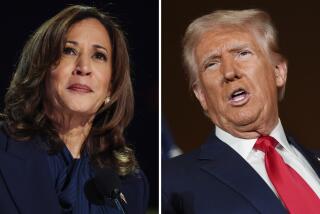Back Into the Thicket With Bush : Capital-Gains Break Would Undo Fairness of Tax Reform
- Share via
As a presidential candidate, George Bush pushed for restoring the tax break that gave a preferential rate to capital gains. He argued that it would increase jobs, promote risk-taking and raise revenue.
If such a simple change to the tax code would accomplish all that, why isn’t everyone jumping onto the bandwagon? What Bush didn’t mention was that his idea would undo half of the principal deal that made tax reform a reality. We traded tax breaks used by the few for lower marginal tax rates for all. Now President Bush proposes to reinstitute the capital-gains break, but no one expects him to offer a marginal rate increase at the same time.
Heading down that path would be a significant break with the Reagan Administration. Congress and President Ronald Reagan found common ground by coupling changes in the marginal rate structure with the closing of loopholes. This process steadily ratcheted down rates and shut down special-interest provisions in the Internal Revenue Code.
There are sound tax policy and equity arguments for maintaining the status quo. The Tax Reform Act of 1986 set marginal rates so low that the rationale for a preferential capital-gains rate no longer made sense.
Advocates of the preference say that we need the lower rate to encourage investors to provide venture capital to risky enterprises, but such investment is only a tiny slice of the capital-investment pie. Certainly you could risk investing $10,000 in a new business that might fail. However, you could also put your $10,000 into IBM stock, gold coins or land. Under the old tax law you got the same preferential rate on a gain from either type of investment.
When you take a look at the equities, though, you cannot avoid the fact that capital-gains realizations are concentrated among highest-income taxpayers. A survey of 1986 tax data by the Internal Revenue Service revealed that 77% of net long-term capital gains were realized by taxpayers with incomes of more than $75,000 (only about 3% of all taxpayers). The survey shows that 57% of net long-term capital gains were realized by taxpayers with incomes of more than $200,000 (a minuscule 0.3% of all taxpayers).
It is plain that any reduction in the rate for capital gains would directly benefit the very wealthiest of taxpayers. Since preference advocates promote the differential as a boon to investment rather than to investors, logic and common sense dictate that this kind of proposal be linked to an increase in the marginal rate for upper-income taxpayers.
Tax policy and equity are not the only considerations. Today changes in the Internal Revenue Code have to be evaluated for potential effect on the deficit. We can’t afford to make the deficit worse.
Even expert opinions on this issue are inconclusive. Reputable studies predict very different revenue consequences for a restored capital-gains rate. The Congressional Joint Committee on Taxation’s analysis of a 15% maximum rate (the current maximum rate is 28%) predicted a $41-billion revenue loss over five years. On the other hand, Harvard Prof. Lawrence Lindsey estimates a three-year gain of $31 billion on the same change to a 15% rate.
Historical evidence is no help, either. The Kennedy rate cut of 1962 generated revenue. However, when the 1981 tax bill lowered the capital-gains rate from 28% to 20%, a Treasury Department study concluded that it had cost the government more than $300 million in the first two years alone.
The bottom line is that the revenue effect of such a fundamental change in the current structure is unknown and unpredictable. With Gramm-Rudman waiting in the wings, can we afford to guess wrong?
Actually, no guessing is required. This is one instance when Congress and the President should keep their hands off. The preferential rate for capital gains was justified under an income-tax system based on high marginal rates and a multitude of adjustments, deductions and preferences. As a result of the Tax Reform Act of 1986, which took the opposite approach, that justification evaporated.
There is no notion more central to tax reform than the idea that individuals with similar incomes ought to pay similar amounts of tax. No principle is more deeply embedded in our tax structure than that the tax burden be distributed based on the ability to pay. Our old tax system paid lip service to those concepts but allowed those who could reduce their tax liability to do so and required those who could not do so to pay higher rates than necessaryin order to compensate. If we re-establish a capital-gains preference, we would be right back on the path that led us to the pre-1986 tax mess.
More to Read
Inside the business of entertainment
The Wide Shot brings you news, analysis and insights on everything from streaming wars to production — and what it all means for the future.
You may occasionally receive promotional content from the Los Angeles Times.










